A Simple Model for Estimating the Hydraulic Conductivity of Unsaturated Soil
Abstract
1. Introduction
2. Methods
2.1. Soil-Water Interaction Mechanisms
2.2. Soil-Water Characteristic Curve Model
2.3. A Simple Model for Estimating the Hydraulic Conductivity of Unsaturated Soil
2.4. Parameter Calibration
3. Results
4. Discussion
5. Conclusions
- (1)
- Depending on the different soil–water interaction mechanisms, the soil–water characteristic curve and the hydraulic conductivity curve can be divided into three segments: the boundary effect zone, transition zone and adsorptive dominant region, where the air-entry value and residual suction are two inflection points.
- (2)
- A simple hydraulic conductivity model for unsaturated soil composed of three straight lines has been proposed. Model parameters can be conveniently calibrated by the measured SWCC and the saturated hydraulic conductivity.
- (3)
- The estimated results, in comparison with the corresponding experimental data, have shown that the proposed model performs well in the estimation of the hydraulic conductivity of different types of soils over a wide suction range.
- (4)
- Compared with existing approaches, the proposed hydraulic conductivity model has a simple form, and it is unnecessary to calibrate the scaling parameter by the measured unsaturated hydraulic conductivity curve.
Author Contributions
Funding
Institutional Review Board Statement
Informed Consent Statement
Data Availability Statement
Acknowledgments
Conflicts of Interest
References
- Aleotti, P. A warning system for rainfall-induced shallow failures. Eng. Geol. 2004, 73, 247–265. [Google Scholar] [CrossRef]
- Le, T.M.H.; Gallipoli, D.; Sanchez, M.; Wheeler, S. Rainfall-induced differential settlements of foundations on heterogeneous unsaturated soils. Géotechnique 2013, 63, 1346–1355. [Google Scholar] [CrossRef]
- Froude, M.J.; Petley, D.N. Global fatal landslide occurrence from 2004 to 2016. Nat. Hazard Earth Syst. 2018, 18, 2161–2181. [Google Scholar] [CrossRef]
- Jeong, S.; Kim, Y.; Park, H.; Kim, J. Effects of rainfall infiltration and hysteresis on the settlement of shallow foundations in unsaturated soil. Environ. Earth Sci. 2018, 77, 494. [Google Scholar] [CrossRef]
- Ng, C.W.W.; Zhou, C.; Chiu, C.F. Constitutive modelling of state-dependent behaviour of unsaturated soils: An overview. Acta Geotech. 2020, 15, 2705–2725. [Google Scholar] [CrossRef]
- Fredlund, D.G.; Xing, A.Q.; Huang, S.Y. Predicting the permeability function for unsaturated soils using the soil-water characteristic curve. Can. Geotech. J. 1994, 31, 533–546. [Google Scholar] [CrossRef]
- Tian, K.; Yang, A.; Nie, K.; Zhang, H.; Xu, J.; Wang, X. Experimental study of steady seepage in unsaturated loess soil. Acta Geotech. 2020, 15, 2681–2689. [Google Scholar] [CrossRef]
- Gallage, C.; Kodikara, J.; Uchimura, T. Laboratory measurement of hydraulic conductivity functions of two unsaturated sandy soils during drying and wetting processes. Soils Found. 2013, 53, 417–430. [Google Scholar] [CrossRef]
- Leong, E.C.; Rahardjo, H. Permeability functions for unsaturated soils. J. Geotech. Geoenviron. 1997, 123, 1118–1126. [Google Scholar] [CrossRef]
- Cai, G.; Zhou, A.; Sheng, D. A permeability function for unsaturated soils with different initial densities. Can. Geotech. J. 2014, 51, 1456–1467. [Google Scholar] [CrossRef]
- Huang, S.Y.; Barbour, S.L.; Fredlund, D.G. Development and verification of a coefficient of permeability function for a deformable unsaturated soil. Can. Geotech. J. 1998, 35, 411–425. [Google Scholar] [CrossRef]
- Agus, S.S.; Leong, E.C.; Schanz, T. Assessment of statistical models for indirect determination of permeability functions from soil–water characteristic curves. Géotechnique 2003, 53, 279–282. [Google Scholar] [CrossRef]
- Childs, E.C.; Collis-George, N. The permeability of porous materials. Proc. R. Soc. Lond. 1950, 210, 392–405. [Google Scholar]
- Marshall, T.J. A relation between permeability and size distribution of pores. J. Soil Sci. 1958, 9, 1–8. [Google Scholar] [CrossRef]
- Millington, R.J.; Quirk, J.P. Permeability of porous media. Nature 1959, 183, 387–388. [Google Scholar] [CrossRef]
- Millington, R.J.; Quirk, J.P. Permeability of porous solids. Trans. Faraday Soc. 1961, 57, 1200–1207. [Google Scholar] [CrossRef]
- Kunze, R.J.; Uehara, G.; Graham, K. Factors Important in the Calculation of Hydraulic Conductivity. Soil Sci. Soc. Am. J. 1968, 32, 760–765. [Google Scholar] [CrossRef]
- Mualem, Y. A new model for predicting the hydraulic conductivity of unsaturated porous media. Water Resour. Res. 1976, 12, 513–522. [Google Scholar] [CrossRef]
- Mualem, Y. Hydraulic conductivity of unsaturated porous media: Generalized macroscopic approach. Water Resour. Res. 1978, 14, 325–334. [Google Scholar] [CrossRef]
- van Genuchten, M.T.H. A closed-form equation for predicting the hydraulic conductivity of unsaturated soils. Soil Sci. Soc. Am. J. 1980, 44, 892–898. [Google Scholar] [CrossRef]
- Tuller, M.; Or, D. Water films and scaling of soil characteristic curves at low water contents. Water Resour. Res. 2005, 41, W09403. [Google Scholar] [CrossRef]
- Peters, A.; Durner, W. A simple model for describing hydraulic conductivity in unsaturated porous media accounting for film and capillary flow. Water Resour. Res. 2008, 44, W11417. [Google Scholar] [CrossRef]
- Tokunaga, T.K. Hydraulic properties of adsorbed water films in unsaturated porous media. Water Resour. Res. 2009, 45, W06415. [Google Scholar] [CrossRef]
- Tokunaga, T.K. Physicochemical controls on adsorbed water film thickness in unsaturated geological media. Water Resour. Res. 2011, 47, W08514. [Google Scholar] [CrossRef]
- Lebeau, M.; Konrad, J.M. A new capillary and thin film flow model for predicting the hydraulic conductivity of unsaturated porous media. Water Resour. Res. 2010, 46, W12554. [Google Scholar] [CrossRef]
- Wang, Y.; Ma, J.; Guan, H. A mathematically continuous model for describing the hydraulic properties of unsaturated porous media over the entire range of matric suctions. J. Hydrol. 2016, 541, 873–888. [Google Scholar] [CrossRef]
- Wang, Y.; Jin, M.; Deng, Z. Alternative Model for Predicting Soil Hydraulic Conductivity over the Complete Moisture Range. Water Resour. Res. 2018, 54, 6860–6876. [Google Scholar] [CrossRef]
- Wang, Y.; Ma, R.; Zhu, G. Improved Prediction of Hydraulic Conductivity with a Soil Water Retention Curve That Accounts for Both Capillary and Adsorption Forces. Water Resour. Res. 2022, 58, e2021WR031297. [Google Scholar] [CrossRef]
- Peters, A. Simple consistent models for water retention and hydraulic conductivity in the complete moisture range. Water Resour. Res. 2013, 49, 6765–6780. [Google Scholar] [CrossRef]
- Peters, A.; Hohenbrink, T.L.; Iden, S.C.; Durner, W. A Simple Model to Predict Hydraulic Conductivity in Medium to Dry Soil from the Water Retention Curve. Water Resour. Res. 2021, 57, e2020WR029211. [Google Scholar] [CrossRef]
- Gou, L.; Zhang, C.; Lu, N.; Hu, S. A Soil Hydraulic Conductivity Equation Incorporating Adsorption and Capillarity. J. Geotech. Geoenviron. 2023, 149, 04023056. [Google Scholar] [CrossRef]
- Corey, A.T.; Brooks, R.H. The Brooks-Corey relationships. In Proceedings of the International Workshop on Characterization and Measurement of the Hydraulic Properties of Unsaturated Porous Media; van Genuchten, M.T., Leij, F.J., Wu, L., Eds.; University of California: Riverside, CA, USA, 1999; pp. 13–18. [Google Scholar]
- Vanapalli, S.K.; Fredlund, D.G.; Pufahl, D.E. The influence of soil structure and stress history on the soil–water characteristics of a compacted till. Géotechnique 1999, 49, 143–159. [Google Scholar] [CrossRef]
- Leong, E.C.; Rahardjo, H. Review of soil-water characteristic curve equations. J. Geotech. Geoenviron. 1997, 123, 1106–1117. [Google Scholar] [CrossRef]
- Fredlund, D.G.; Xing, A.Q. Equations for the soil-water characteristic curve. Can. Geotech. J. 1994, 31, 521–532. [Google Scholar] [CrossRef]
- Gao, Y.; Sun, D.A. Determination of basic parameters of unimodal and bimodal soil water characteristic curves. Chin. J. Geotech. Eng. 2017, 39, 1884–1891. [Google Scholar]
- Lu, N.; Zhang, C. Soil sorptive potential: Concept, theory, and verification. J. Geotech. Geoenviron. 2019, 145, 04019006. [Google Scholar] [CrossRef]
- Chen, K.; Chen, H. Generalized hydraulic conductivity model for capillary and adsorbed film flow. Hydrogeol. J. 2020, 28, 2259–2274. [Google Scholar] [CrossRef]
- Langmuir, I. Repulsive forces between charged surfaces in water, and the cause of the Jones-ray effect. Science 1938, 88, 430–432. [Google Scholar] [CrossRef]
- Derjaguin, B.V.; Churaev, N.V.; Muller, V.M. Surface Forces; Plenum: New York, NY, USA, 1987. [Google Scholar]
- Zhai, Q.; Rahardjo, H. Determination of soil–water characteristic curve variables. Comput. Geotech. 2012, 42, 37–43. [Google Scholar] [CrossRef]
- Zhai, Q.; Rahardjo, H. Estimation of permeability function from the soil–water characteristic curve. Eng. Geol. 2015, 199, 148–156. [Google Scholar] [CrossRef]
- Zhang, D. A Coefficient of Determination for Generalized Linear Models. Am. Stat. 2017, 71, 310–316. [Google Scholar] [CrossRef]
- Nemes, A.D.; Schaap, M.G.; Leij, F.J.; Wösten, J.H.M. Description of the unsaturated soil hydraulic database UNSODA version 2.0. J. Hydrol. 2001, 251, 151–162. [Google Scholar] [CrossRef]
- Pachepsky, Y.; Scherbakov, R.; Varallyay, G.; Rajkai, K. On obtaining soil hydraulic conductivity curves from water retention curves. Pochvovedenie 1984, 10, 60–72. [Google Scholar]
- Mualem, Y. A Catalogue of the Hydraulic Properties of Unsaturated Soils; Technical Report; Israel Institute of Technology: Haifa, Israel, 1976. [Google Scholar]
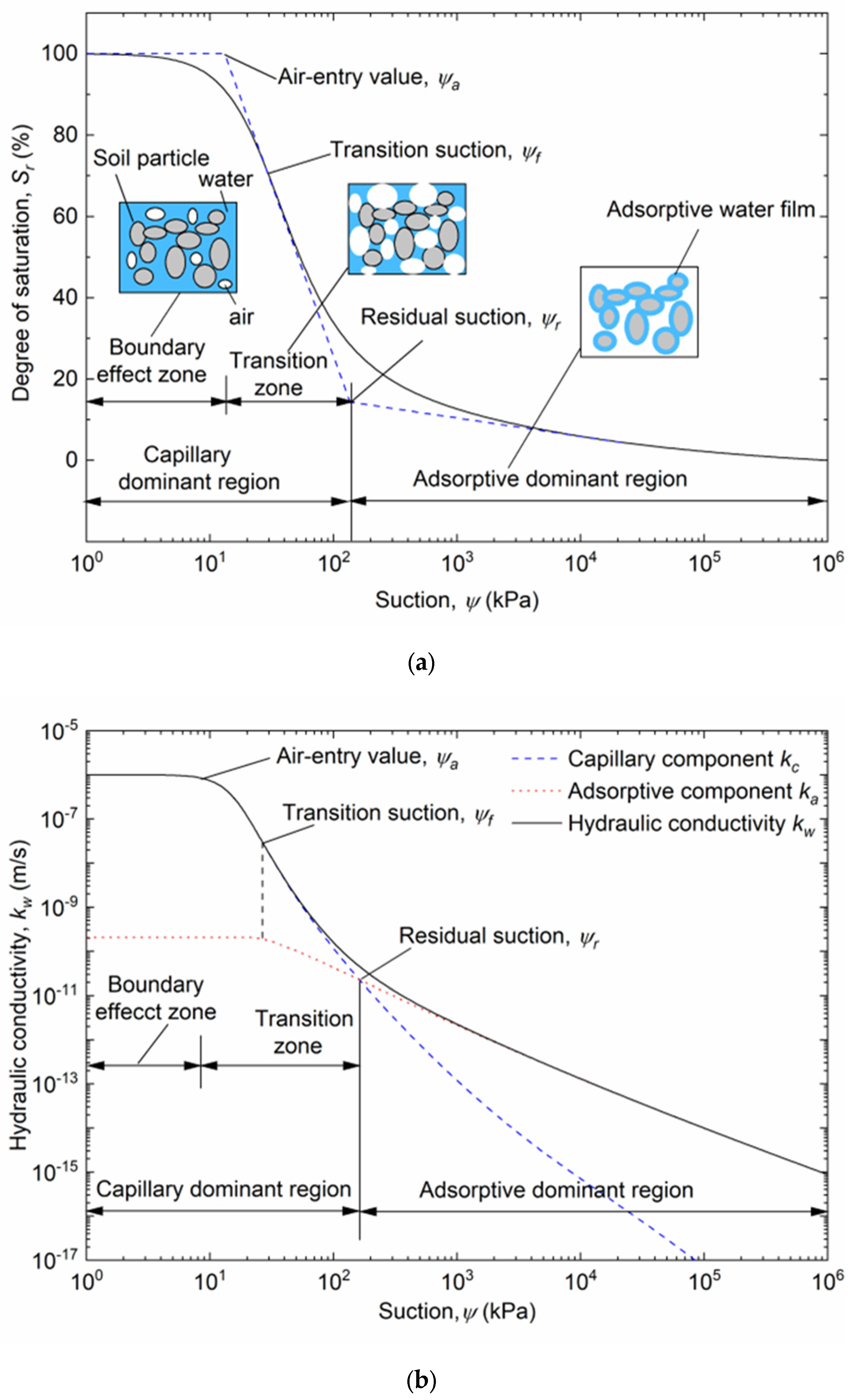
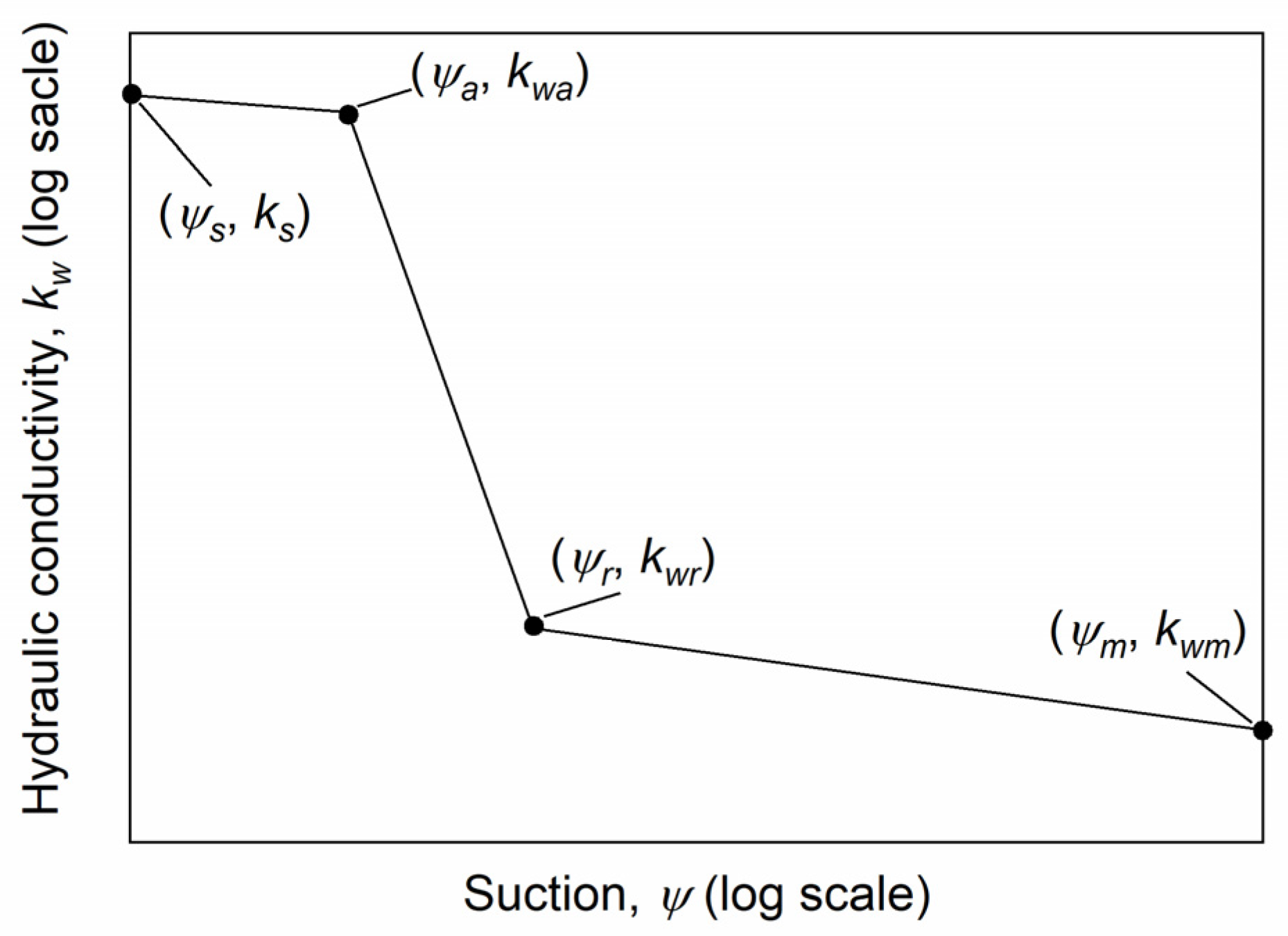
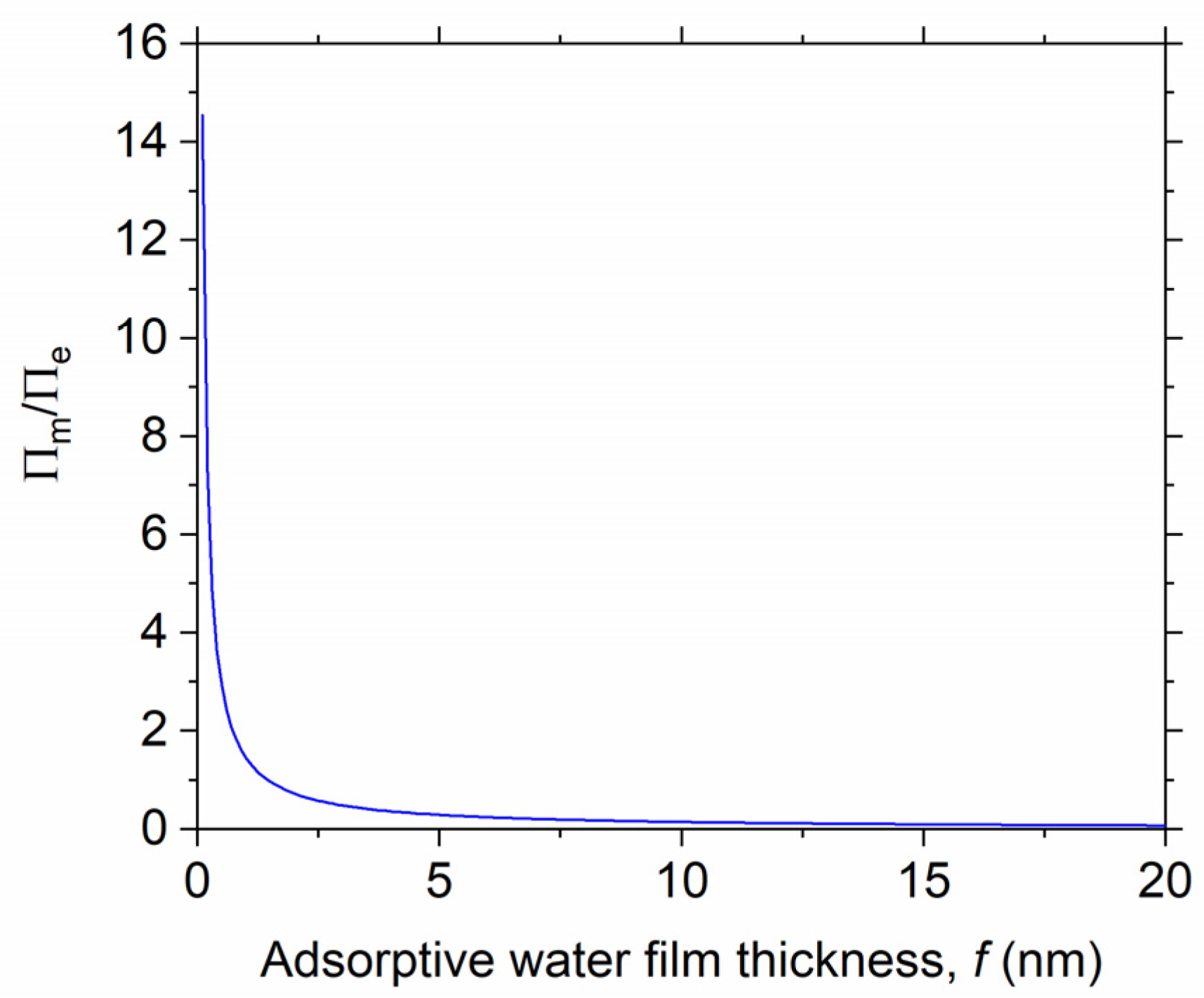
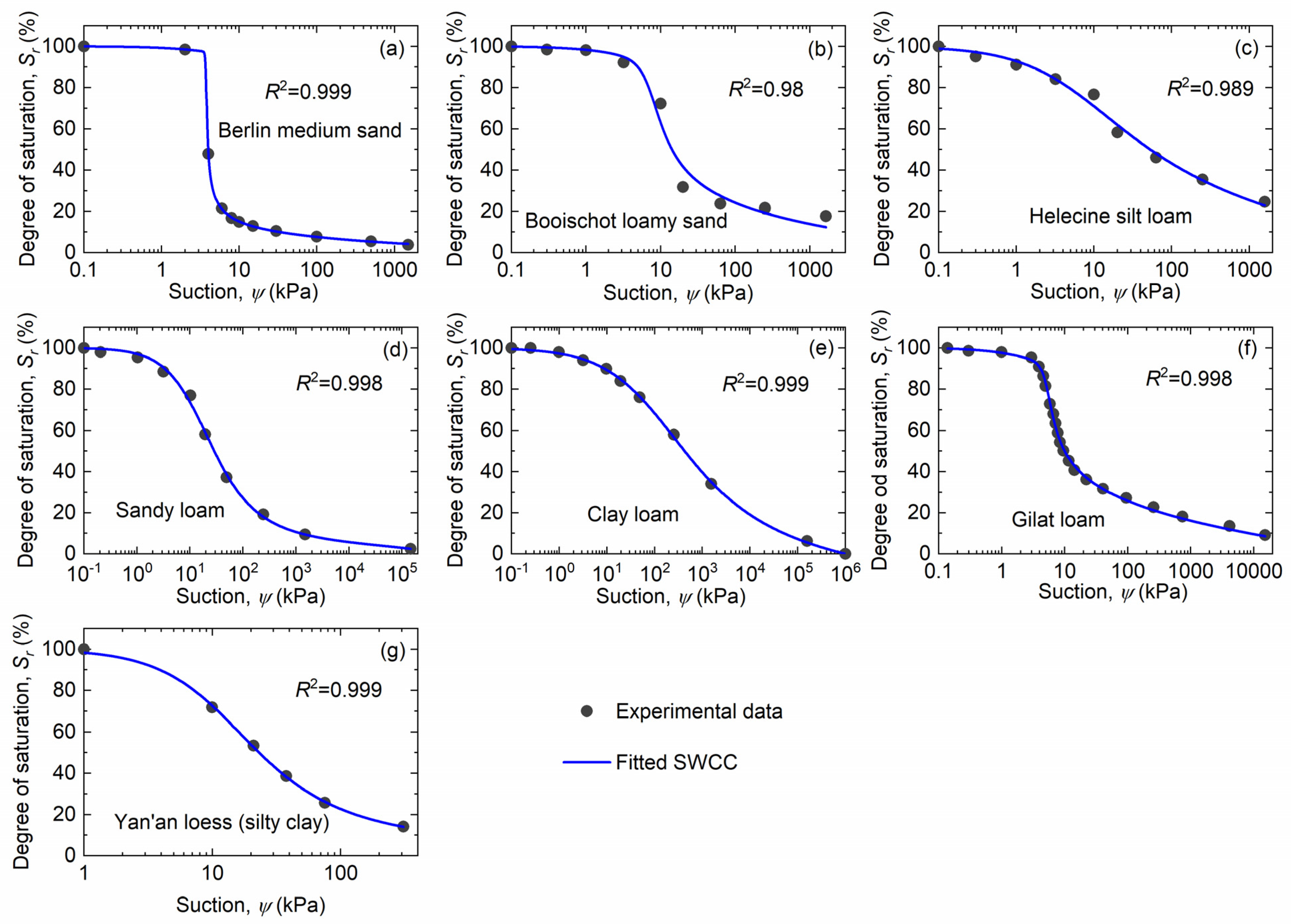
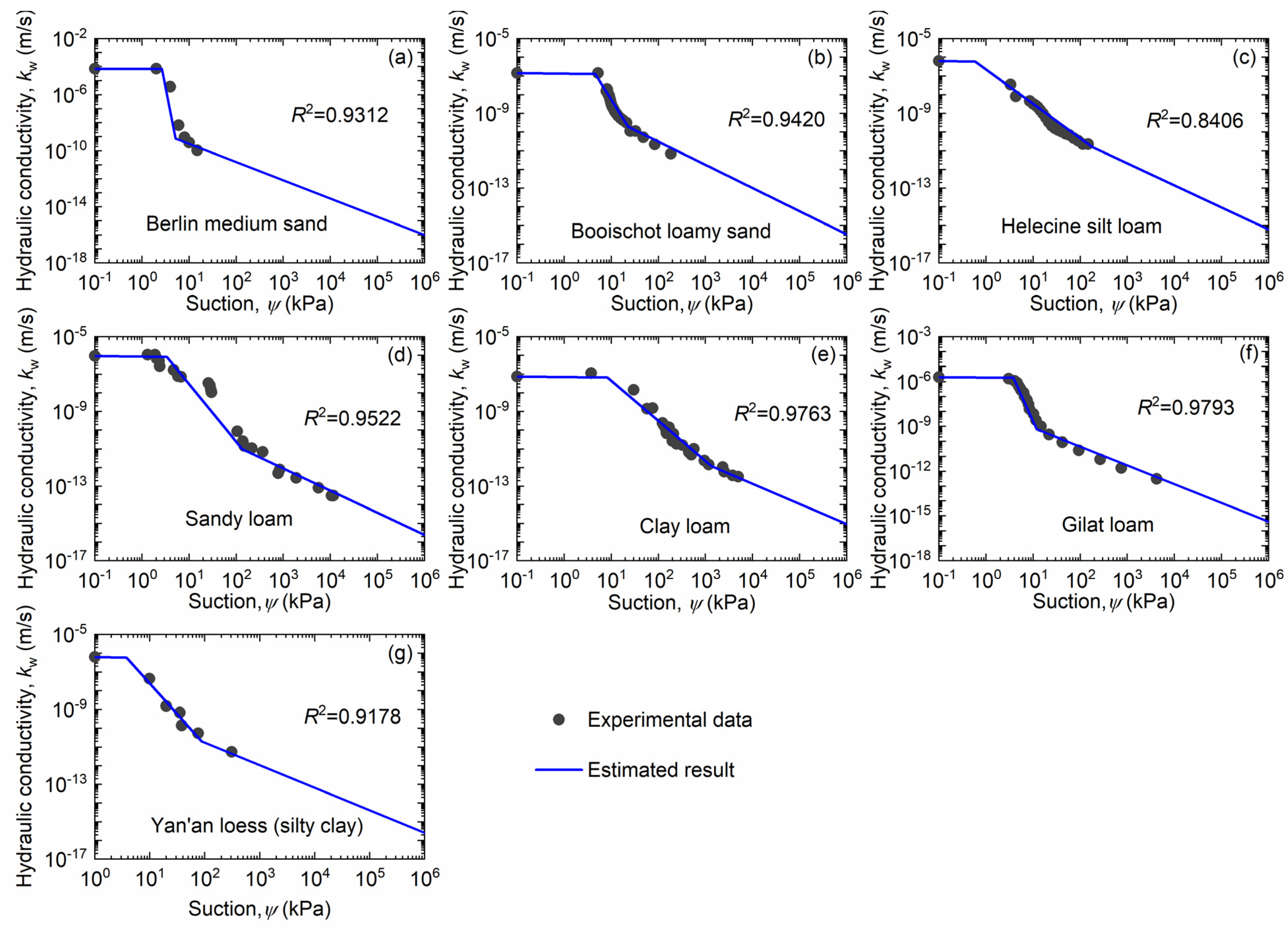
| Soil Name | Reference | Porosity | Saturated Hydraulic Conductivity |
|---|---|---|---|
| n’ | ks (m/s) | ||
| Berlin medium sand | Nemes et al. [44] | 0.388 | 7.30 × 10−5 |
| Booischot loamy sand | Nemes et al. [44] | 0.437 | 1.42 × 10−7 |
| Helecine silt loam | Nemes et al. [44] | 0.443 | 6.30 × 10−7 |
| Sandy loam | Pachepsky et al. [45] | 0.43 | 9.26 × 10−7 |
| Clay loam | Pachepsky et al. [45] | 0.5 | 7.52 × 10−8 |
| Gilat loam | Mualem [46] | 0.44 | 2.0 × 10−6 |
| Yan’an loess (silty clay) | Tian et al. [7] | 0.47 | 6.43 × 10−7 |
| Soil Name | a | m | n | Cr | Ψs (kPa) | Ψa (kPa) | Ψr (kPa) | Ψm,m (kPa) | Sra (%) | Srm,m (%) |
|---|---|---|---|---|---|---|---|---|---|---|
| Berlin medium sand | 3.715 | 0.432 | 69.32 | 10.578 | 0.1 | 2.65 | 5.16 | 10,000 | 93.5 | 2.64 |
| Booischot loamy sand | 6.6 | 0.443 | 4.567 | 4.225 | 0.1 | 4.59 | 22.88 | 10,000 | 91.4 | 7.85 |
| Helecine silt loam | 3.416 | 0.523 | 0.828 | 6.209 | 0.1 | 0.59 | 179.76 | 10,000 | 92.4 | 14.29 |
| Sandy loam | 13.195 | 1.417 | 1.114 | 1.6 × 105 | 0.1 | 3.37 | 133.48 | 10,000 | 90 | 5.7 |
| Clay loam | 40.609 | 0.843 | 0.652 | 330.225 | 0.1 | 8.2 | 1344.87 | 10,000 | 90.5 | 19.08 |
| Gilat loam | 4.832 | 0.323 | 7.888 | 2.811 | 0.1 | 3.83 | 11.84 | 10,000 | 91.6 | 9.59 |
| Yan’an loess (silty clay) | 10.82 | 1.273 | 1.386 | 1.65 × 1016 | 1 | 3.784 | 87.641 | 10,000 | 90.4 | 5.66 |
Disclaimer/Publisher’s Note: The statements, opinions and data contained in all publications are solely those of the individual author(s) and contributor(s) and not of MDPI and/or the editor(s). MDPI and/or the editor(s) disclaim responsibility for any injury to people or property resulting from any ideas, methods, instructions or products referred to in the content. |
© 2024 by the authors. Licensee MDPI, Basel, Switzerland. This article is an open access article distributed under the terms and conditions of the Creative Commons Attribution (CC BY) license (https://creativecommons.org/licenses/by/4.0/).
Share and Cite
Zhang, Z.; Zhang, M. A Simple Model for Estimating the Hydraulic Conductivity of Unsaturated Soil. Appl. Sci. 2024, 14, 1254. https://doi.org/10.3390/app14031254
Zhang Z, Zhang M. A Simple Model for Estimating the Hydraulic Conductivity of Unsaturated Soil. Applied Sciences. 2024; 14(3):1254. https://doi.org/10.3390/app14031254
Chicago/Turabian StyleZhang, Ziran, and Maosheng Zhang. 2024. "A Simple Model for Estimating the Hydraulic Conductivity of Unsaturated Soil" Applied Sciences 14, no. 3: 1254. https://doi.org/10.3390/app14031254
APA StyleZhang, Z., & Zhang, M. (2024). A Simple Model for Estimating the Hydraulic Conductivity of Unsaturated Soil. Applied Sciences, 14(3), 1254. https://doi.org/10.3390/app14031254







